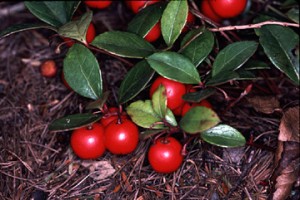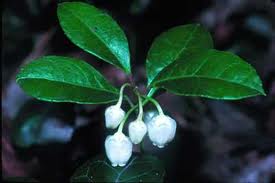The Teaberry Shuffle
I saw Gary Vickerson eat an earthworm I found near a Checkerberry plant. Personally I preferred the Checkerberry.
Before I go any further let it be known the Checkerberry is also called — in English — Johnny Jump Ups, Wintergreen, Teaberry, Boxberry, Mountain Tea, Canadian Mint, Deerberry, Leatherleaf, Groundtea, Groundberry, Hillberry, Mountainberry, Patridgeberry, Grouseberry, Spiceberry, Redberry Tea, Wax Cluster and Ivoryberry. The Ojibwa called it Winisbugons … “Dirty Leaf” … and the French la Petit te du bois, “The Little Tea of the Woods.” Its scientific name is Gaultheria procumbens, ( Gol-THAIR-ee-uh proh-KUM-benz) named after Jean Francois Gaultier a court physician in Quebec. Procumbens means trailing but not rooting, nearly flat on the ground.
Back to Gary: I was about to start high school and Gary was less than half my age. He ate the worm, dirt and all, and laughed about it. No threats. No bribe. No “dare ya.” He just looked at it then ate it. Oddly, he was the only kid in that family of six who turned out all right.
The checkerberries grew on a low hillside between our houses, which were about a half a mile apart through the woods. It was probably just one checkerberry because it is their habit to send roots everywhere and pop up everywhere giving the impression of a patch when it is but a single individual plant. Every year I marveled how they were the first plants to bear fruit after the snow left. It wasn’t until years later that I learned the berries overwintered under the snow and are already there when the snow melted. At any rate I looked forward to them every April or so. In large fields of dead brown grass the verdant wintergreen and its red berries were easy to spot. Perhaps the birds had the same idea. And if I couldn’t find a berry, I’d chew on the leaves, lightly wintergreen with a slightly bitter after taste.
At one time it was very popular as tea, hence the name Teaberry but people have forgotten how to make Teaberry tea. While its leaves and branches can make a mild tea through normal drying and seeping in hot water there is a better way: Ferment the leaves in warm sterile water for a few days until they begin to bubble. Then use those leaves for tea, either wet from the fermentation vessel or dry them. And while it makes an excellent tea, it is a tea containing methyl salicylate… so think of it as a pleasant aspirin. Given the choice of an aspirin a day or a cup of checkerberry tea I’ll take the original.
Man is also not the only forager of checkerberries. They provide food for squirrels, chipmunks, deer mice, grouse, partridges, bobwhites, turkeys, fox deer and bears.
One next to last thing: Why was the plant named after Jean-François Gaultier? He was the king’s official physician and naturalist assigned to Quebec, or New France as it was known then. He arranged for fort commanders to collect plant specimens for him, a task I am sure they enjoyed. In 1749 Gaultier and a botanical friend, Swede Pehr Kalm, rummaged around the plants of Québec City and Kalm named the checkerberry after Gaultier.
Gaultier, by the way, was more than a mere dilettante doctor cum tree hugger. He shipped plants to France every year. His 1749 manuscript lists 134 species, many of which he was the first to mention including four different species of pine. He also set up the first weather station in Canada and kept a log from 1742 to 1756. Not just interested in plants, he sent minerals and preserved animals back to France for the scientists of the day. His main interest, however, was the medical properties of plants. He even managed to write the history of maple sugar… talk about a sweet job.
Green Deane’s “Itemized” Plant Profile
IDENTIFICATION:
Alternate leaves, simple, evergreen, oval to elliptical, 1 to 2 inches long, tiny teeth, stiff with a wintergreen odor when crushed, leaves cluster at tip of plant; dark shiny green above, paler below often with black dots. Flower small, quarter-inch, white, urn-shaped, hanging from short stems in mid to late summer. Fruit is red, round, 1/4 to 1/2 inch through, hanging beneath leaves, mild wintergreen taste, ripen in late summer, can last through winter. To six inches high.
TIME OF YEAR:
Berries fall or spring, under the snow if you can find them. Leaves year round, eastern North American down to northern Georgia.
ENVIRONMENT:
Sandy soil in northern fields and cool damp woodlands
METHOD OF PREPARATION:
Berries out of hand, leaves as tea, fresh, dried or fermented.
HERB BLURB
Comparison of Oral Aspirin Versus Topical Applied Methyl Salicylate for Platelet Inhibition
David A Tanen, MD, Medical Toxicologist, Department of Emergency Medicine, Naval Medical Center San Diego, San Diego, CA
BACKGROUND: Oral acetylsalicylic acid (aspirin) is the primary antiplatelet therapy in the treatment of acute myocardial infarction and acute coronary syndrome. Methyl salicylate (MS; oil of wintergreen) is compounded into many over-the-counter antiinflammatory muscle preparations and has been shown to inhibit platelet aggregation locally and to be absorbed systemically.
OBJECTIVE: To assess the ability of topically applied MS to inhibit systemic platelet aggregation for patients who are unable to tolerate oral drug therapy.
METHODS: A randomized, prospective, blinded, crossover study was conducted in 9 healthy men, aged 30–46 years. All subjects ingested 162 mg of aspirin or applied 5 g of 30% MS preparation to their anterior thighs. There was a minimum 2-week washout period between study arms. Blood and urine were collected at baseline and at 6 hours. An aggregometer measured platelet aggregation over time against 5 standard concentrations of epinephrine, and a mean area under the curve (AUC) was calculated. Urinary metabolites of thromboxane B2 were measured by a standard enzyme immunoassay. Differences in and between groups at baseline and 6 hours were tested by the Wilcoxon signed-rank test.
RESULTS: Baseline platelet aggregation did not differ significantly between the 2 arms of the study (median AUC [% aggregation*min]; binominal confidence intervals): aspirin 183; 139 to 292 versus MS 197; 118 to 445 (p = 0.51). Both aspirin and MS produced statistically significant platelet inhibition; aspirin decreased the AUC from 183; 139 to 292 to 85; 48 to 128 (p = 0.008) and MS decreased the AUC from 197; 118 to 445 to 112; 88 to 306 (p = 0.011). No significant difference was detected between baseline and 6-hour thromboxane levels for either aspirin (p = 0.779) or MS (p = 0.327).
CONCLUSIONS: Topical MS and oral aspirin both significantly decrease platelet aggregation in healthy human volunteers.



